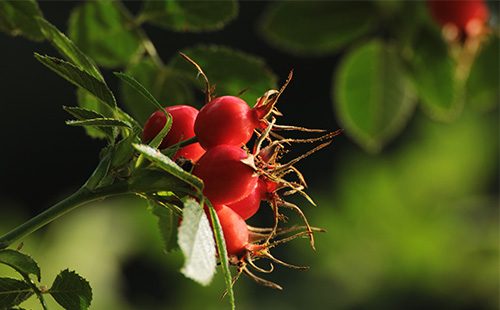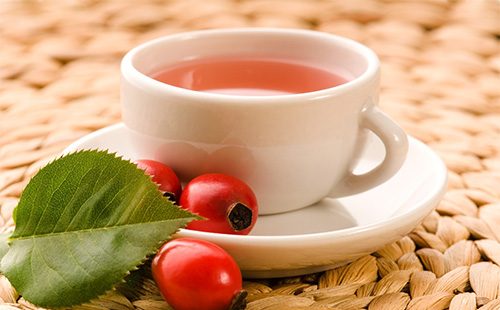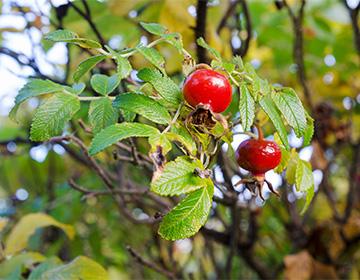The content of the article
The culture belongs to the Pinks family. More than 200 species are reckoned to its genus, 30 of which have medicinal properties. On the territory of Russia, rosehip May (cinnamon) is grown as a medicinal plant. It is believed that in terms of the content of useful substances it is significantly superior to dog rose. However, the latter species is more common.
In Russia, culture is found almost everywhere, as it is characterized by its unpretentiousness and frost resistance. It is an inhabitant of meadows, undergrowths and fringes in the forest zone.
Botanical characteristic
Rosehip and rose are synonyms. Grown as a source of healthy fruits, for landscaping, creating hedges. Thanks to the many thorns, it also performs a practical role - it protects the yard from the invasion of strangers. In European countries, whole cinnamon plantations are cultivated for the procurement of medicinal raw materials on an industrial scale.
In the wild, found in the steppes and forests, on roadsides. It grows well on rocky soils. In the mountains, it can be located at an altitude of up to 2200 m. You can recognize a useful plant by morphological characteristics.
- General form. Both May and dog roses are perennial shrub plants reaching 2 m in height. Multiple drooping branches form a sparse bush. The cinnamon look has a more compact crown.
- The stalks. Leafy stems have many spines on the surface. The bark is smooth, brown with a reddish tint. The stems branch at the top.
- Leaves. Unpaired leaves have two bent prickly stipules. They consist of three to seven pairs of obovate leaf plates with a matte wrinkled surface. Color - dark green on the upper side, and bluish - on the bottom. There are curved thorns near each pair of leaves. The edges of the sheet plates are serrate.
- Flowers. The plant blooms in late spring - early summer, forming single flowers. They have a pale pink color for a dog rose, pink-red for May.
- Fruit. Ripen from August to September. Represented by numerous faceted nuts, which are enclosed in juicy hypanthium - an overgrown receptacle. Inside, it is covered with many hard bristles.
Harvesting raw materials
Dried fruits are most often considered as medicinal raw materials for canine and May roses. (In folk medicine, leaves, flowers and roots are rarely used). They can be purchased at the pharmacy or prepared on their own.
- Collection. Procurement begins in August-September. Only fully ripened red berries are suitable for picking. They are torn off or cut off from the bush, protecting hands with gloves.
- Training. The collected raw materials are sorted out, discarding discolored, unripe, sluggish and damaged berries.
- Drying. They are laid out on a pallet in a thin layer. The raw materials are placed in a warm attic or dried in a dryer, observing a temperature of up to 80 ° C. In the process, the fruits are turned over.
If everything is done correctly, then the output produces dark red berries that do not fall apart and do not stick together when squeezed in the palm of your hand. They should not be sticky. After drying, the raw materials are re-sorted, removing the browned and blackened elements.
Composition and properties
In the composition of pulp and nuts, large concentrations are noted:
- ascorbic acid;
- thiamine;
- riboflavin;
- routine;
- vitamin K.
Due to its powerful vitamin composition, culture has the following effects on the human body:
- anti-inflammatory - ascorbic acid acts as an important participant in the production of hormones that have anti-inflammatory effects;
- immunostimulatory - The vitamin composition of berries increases the nonspecific resistance of the body;
- metabolic - vitamins are involved in carbohydrate and mineral metabolism;
- vasoprotective - rutin and ascorbic acid reduce vascular permeability, strengthen vascular walls;
- anti-sclerotic - optimization of metabolic processes prevents atherosclerosis and the formation of atherosclerotic plaques;
- hemostatic- Vitamin K normalizes the formation of blood clots and prevents internal bleeding.
In addition to vitamins, the fruits contain flavonoids, anthocyanins, fatty acids, pectin compounds, tannins, organic acids, sugars. Thanks to acids, raw materials stimulate the secretion of bile and digestive juices, anthocyanins - has an antioxidant effect. Tannins give fruits astringent properties, and pectins - cleansing. Flavonoids stimulate hematopoiesis, improve myocardial function, have a moderate sedative effect on the central nervous system.

Diseases for which it helps
Thanks to a comprehensive beneficial effect on the body, the plant is prescribed with an extensive list of ailments. Raw materials are especially actively used in alternative medicine.
- For colds. As a general strengthening agent, they are taken for colds and SARS, lung diseases. A beneficial effect of the plant on the body of patients with asthmatic status was noted, since a lack of ascorbic acid provokes an increase in seizures. It is useful to use tea from berries to prevent colds in the cold season.
- With diseases of the gastrointestinal tract. Rosehip improves the secretion of digestive juices, normalizes the production of bile. Due to its mild antibacterial properties, it eliminates dysbiosis and the accompanying bloating. Astringent properties of fruits are appropriate for dyspeptic disorders and infectious diarrhea.
- Like a diuretic. Dog rose improves the formation of urine, removes excess fluid from the body, and also relieves inflammation of the kidneys and urinary tract. The diuretic effect is relevant in the treatment of hypertension, with pyelonephritis, cystitis, to prevent the formation of calculi.
- To improve the condition of blood and blood vessels. Plant preparations are useful for anemia. Ascorbic acid normalizes the absorption of iron, and other vitamins and biologically active compounds stimulate blood formation. The use of the plant for patients with malignant blood diseases has been noted.Also, a rose is prescribed for fragility of capillaries, varicose veins, for the prevention of internal and treatment of nosebleeds.
- With metabolic failures. The plant is useful for diabetics, as it regulates blood sugar. Extracts from the fruits lower cholesterol and normalize lipid metabolism. As an aid, it is used for weight loss.
- With skin diseases. Fruit preparations are used to treat various skin lesions. They have antibacterial, anti-inflammatory, regenerative effects. Raw materials are also actively used in cosmetology - as a bleaching and anti-aging agent.
- With diseases of bones and joints. The benefits of culture are manifested in the complex therapy of gout. The plant normalizes mineral metabolism, removes excess salts from the body, and also has a systemic anti-inflammatory effect in rheumatism, arthrosis, arthritis.
- From vitamin deficiency. Rosehip is one of the first means used by mankind to prevent scurvy. How vitamin raw materials are used for unbalanced nutrition, as well as for restoring vitamins in the body after the winter period.
Contraindications
Rosehip is considered a safe plant material. Contraindications - the minimum amount:
- endocarditis;
- gastritis with high acidity;
- acute gastrointestinal diseases;
- violations of the mineralization of tooth enamel;
- individual sensitivity reactions;
- thrombophlebitis.
Use with caution in children and pregnant women. Rose preparations are not contraindicated in these categories of the population, however, they should be taken only as directed by the doctor. The same situation occurs with breastfeeding. Theoretically, rosehip will be useful as a source of vitamin C and other nutrients, but the diuretic effect may adversely affect the amount of breast milk.
Pharmacy products
In pharmacies, you can buy ready-made preparations based on rose hips. These are vitamin teas in loose and packaged versions, as well as syrup and butter.
- Butter. Used in ENT practice. They also treat the throat, mucous membranes of the nose, gums for dental problems. Also used in the treatment of minor skin lesions, sunburn, dermatitis, allergic and inflammatory nature.
- Syrup. For example, "Holosas" with the addition of echinacea or other extracts. Use as a mild choleretic agent, to stimulate the immune system, accelerate recovery from colds.
Prescription Drugs
At home, water extracts from fruits are most often used - decoctions, infusions, tea. Alcohol tincture is recommended for hypotensive patients and people with vegetovascular dystonia. Such a remedy is good for the heart, improves blood circulation, normalizes blood pressure, but it contains few vitamins.
Tea
Features Brew berries should be in a glass bowl with a lid. It is advisable to additionally wrap the vessel with a towel - this will increase the concentration of nutrients in the drink.
Preparation and use
- A tablespoon of fruit is poured with a glass of boiling water.
- Insist under the lid for half an hour.
- After straining, add honey or sugar.
- Use up to three glasses a day.
Infusion
Features Drink under all conditions that are related to the indications for the use of rose hips. Also used externally for flushing and compresses.
Preparation and use
- Two tablespoons of fruit are poured with a cup of boiling water in a thermos.
- Insist the remedy for two to four hours.
- After straining, take half a glass orally up to four times a day.

Decoction
Features Prolonged heating of extracts from the plant reduces the content of ascorbic acid and other vitamins in them, however, it increases the number of anthocyanins, flavonoids, pectins, tannins. Decoctions are appropriate to use for inflammatory lesions of the gastrointestinal tract, as well as a diuretic. Brew should be in a water bath.
Preparation and use
- Two tablespoons of the raw material are poured into 300 ml of boiling water, put in a water bath, simmer for 20 minutes.
- Insist the remedy for an hour, after which it is filtered.
- Take orally in half a glass up to four times a day.
As a means of losing weight, tea from berries is used. It removes excess fluid and normalizes metabolic processes. Pink syrup is not used for this purpose, as well as for diabetes. This is due to the high concentration of sugar in the composition of the drug. When using oil for cosmetic purposes, it is possible to stain the skin in orange or pink.

